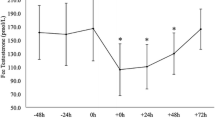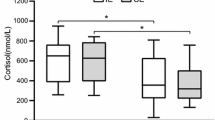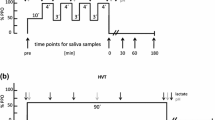Abstract
In eight top-level male endurance swimmers the aerobic performance and the response to exercise of total testosterone (T), free testosterone (fT), sex hormone binding globulin (SHBG), non-SHBG-bound testosterone (NST) and cortisol (C) were evaluated during a training season. The swimmers participated in three test sessions which occurred 6, 12 and 24 weeks after the beginning of the season. During each session, after a standard warm-up, the swimmers performed a set of 15 × 200-m freestyle, with a 20-s rest between repetitions, at a predetermined individual speed. Three blood samples were collected: before warm-up, at the end of the set, and after 1 h of recovery. A few days before each session, the individual swimming velocity associated with a 4 mmol · l−1 blood lactate concentration (ν4) was assessed as a standard of aerobic performance. The values of ν4 were lower in the second session than in the third one. The concentrations of C, which increased after the exercise, showed the highest values in the second session. The values of T and the T: SHBG ratio increased after the exercise but returned to their initial concentrations during the recovery period. The values of fT and NST increased after the exercise in the first and third sessions. In the initial two sessions, when the aerobic performance was still low, the concentrations of NST decreased to below the initial values after recovery. In session III, when the adaptation to the training workload was complete, NST returned to resting concentrations after recovery. The results would suggest that stressful stimuli produced by an increase in training volume may induce changes in androgen metabolism during exercise. In this respect, NST would appear to be a better index of metabolic response than T, T/SHBG and fT.
Similar content being viewed by others
References
Bonifazi M, Martelli G, Marugo L, Sardella F, Carli G (1993) Blood lactate accumulation in top level swimmers following competition. J Sports Med Phys Fitness 33:13–18
Busso T, Hakkinen K, Pakarinen A, Carasso C, Lacour JR, Komi PV, Kauhanen H (1990) A systems model of training responses and its relationship to hormonal responses in elite weight-lifters. Eur J Appl Physiol 61:48–54
Caballero MJ, Mena P, Maynar M (1992) Changes in sex hormone binding globulin, high density lipoprotein cholesterol and plasma lipids in male cyclists during training and competition. Eur J Appl Physiol 64:9–13
Carli G, Martelli G, Viti A, Baldi L, Bonifazi M, Lupo di Prisco C (1983) Modulation of hormone levels in male swimmers during training. In: Hollander AP, Huijing PA, de Groot G (eds) Biomechanics and medicine in swimming. Human Kinetics, Champaign, Ill., pp 33–40
Carter GD, Holland SM, Alaghband-Zadeh J, Ragman G, Darrington-Ward P, Wise PH (1983) Investigation on hirsutism: testosterone is not enough. Ann Clin Biochem 20:262–263
Cumming DC, Wall SR (1985) Non-sex hormone-binding globulin-bound testosterone as a marker for hyperandrogenism. J Clin Endocrinol Metab 61:873–876
Cumming DC, Quigley ME, Yen SSC (1983) Acute suppression of circulating testosterone level by cortisol in men. J Clin Endocrinol Metab 57:671–673
Galbo H (1983) Hormonal and metabolic adaptation to exercise. Thieme, Stuttgart
Gray AB, Telford RD, Weidemann MJ (1993) Endocrine response to intense interval exercise. Eur J Appl Physiol 66:366–371
Hackney AC (1989) Endurance training and testosterone levels. Sports Med 8:117–127
Hakkinen K, Pakarinen A, Alen M, Kauhanen H, Komi PV (1988) Neuromuscular and hormonal responses in elite athletes to two successive strength training sessions in one day. Eur J Appl Physiol 57:133
Houmard JA, Costill DL, Mitchell JB, Park SH, Fink WJ, Burns JM (1990) Testosterone, cortisol, and creating kinase levels in male distance runners during reduced training. Int J Sports Med 11:41–45
Kapoor P, Luttrell BM, Williams D (1993) The free androgen index is not valid for adult males. J Steroid Biochem Molec Biol 45:325–326
Keizer H, Janssen GME, Menheere P, Kranenburg G (1989) Changes in basal plasma testosterone, cortisol, and dehydroepiandrosterone sulfate in previously untrained males and females preparing for a marathon. Int J Sports Med 10:S139-S145
Key TJA, Roe L, Thorogood M. Moore JW, Clark GMG, Wang DY (1990) Testosterone, sex hormone-binding globulin, calculated free testosterone, and oestradiol in male vegans and omnivores. Br J Nutr 64:111–119
Kipke L (1985) The importance of recovery after training and competitive efforts. NZ J Sports Med 13:120–128
Kuoppasalmi K, Adlercreutz H (1985) Interaction between anabolic and catabolic hormones in muscular exercise. In: Fotherby K, Pal SB (eds) Exercise endocrinology. De Gruyter, Berlin, pp 65–120
Kuoppasalmi K, Naveri H, Harkonen M, Adlercreutz H (1980) Plasma cortisol, androstenedione, testosterone and luteinizing hormone in running exercise of different intensities. Scand J Lab Invest 40:403–409
Leszczynski DE, Kokatnur MG, Kummerow FA (1987) Serum sex hormone binding globulin and high density lipoprotein cholesterol in male patients at risk for coronary heart disease. Med Sci Res 15:575
Lugar A, Deuster PA, Kyle SB, Gallucci WT, Montgomery LC, Gold PW, Loriaux DL, Chrousos GP (1987) Acute hypothalamic-pituitary-adrenal responses to the stress of treadmill exercise N Engl J Med 48:177–188
Mader A, Madsen O, Hollmann W (1980) Zur Beurteilung der lactaziden Energicbereitstellung für Trainings- und Wettkampfleistungen im Sportschwimmen. Leistungssport 10:263–408
Manni A, Partridge WM, Cefalu M (1985) Bioavailability of albumin-bound testosterone. J Clin Endocrinol Metab 61:705–710
Remes K, Kuoppasalmi K, Adlercreutz H (1985) Effect of physical exercise and sleep deprivation on plasma androgen levels: modifying effect of physical fitness. Int J Sports Med 6:131–135
Snedecor GW, Cochran WG (1980) Statistical methods. The Iowa State University Press, Ames, Iowa
Sodergard R, Backstrom T, Shanbag V, Cartensen H (1982) Calculation of free and bound fractions of testosterone and estradiol 17β to human plasma proteins at body temperature. J Steroid Biochem 18:801
Toscano V, Balducci R, Bianchi P, Guglielmi R, Mangiantini A, Sciarra F (1992) Steroidal and non-steroidal factors in plasma sex hormone binding globulin regulation. J Steroid Biochem Molec Biol 43:431–437
Urhausen A, Kindermann W (1987) Behaviour of testosterone, sex hormone binding globulin (SHBG), and cortisol before and after a triathlon competition. Int J Sports Med 8:305–308
Vermeulen A, Verdonck L, Van der Straeten M (1969) Capacity of testosterone binding globulin in human plasma and the influence on specific binding of testosterone on its metabolic clearance rate. J Clin Endocrinol Metab 29:1470–1480
Von Schoultz B, Carlstrom K (1989) On the regulation of sexhormone-binding globulin — a challenge of an old dogma and outlines of an alternative mechanism. J Steroid Biochem 32:327
Wheeler GD, Wall SR, Belcastro AN, Cumming DC (1984) Reduced serum testosterone and prolactin levels in male distance runners. J AM Med Assoc (Chicago) 252:514–516
Wilkerson J, Horvath S, Gutin B (1980) Plasma testosterone during treadmill exercise. J Appl Physiol 49:249–253
Author information
Authors and Affiliations
Rights and permissions
About this article
Cite this article
Bonifazi, M., Bela, E., Carli, G. et al. Influence of training on the response of androgen plasma concentrations to exercise in swimmers. Eur J Appl Physiol 70, 109–114 (1995). https://doi.org/10.1007/BF00361537
Accepted:
Issue Date:
DOI: https://doi.org/10.1007/BF00361537




